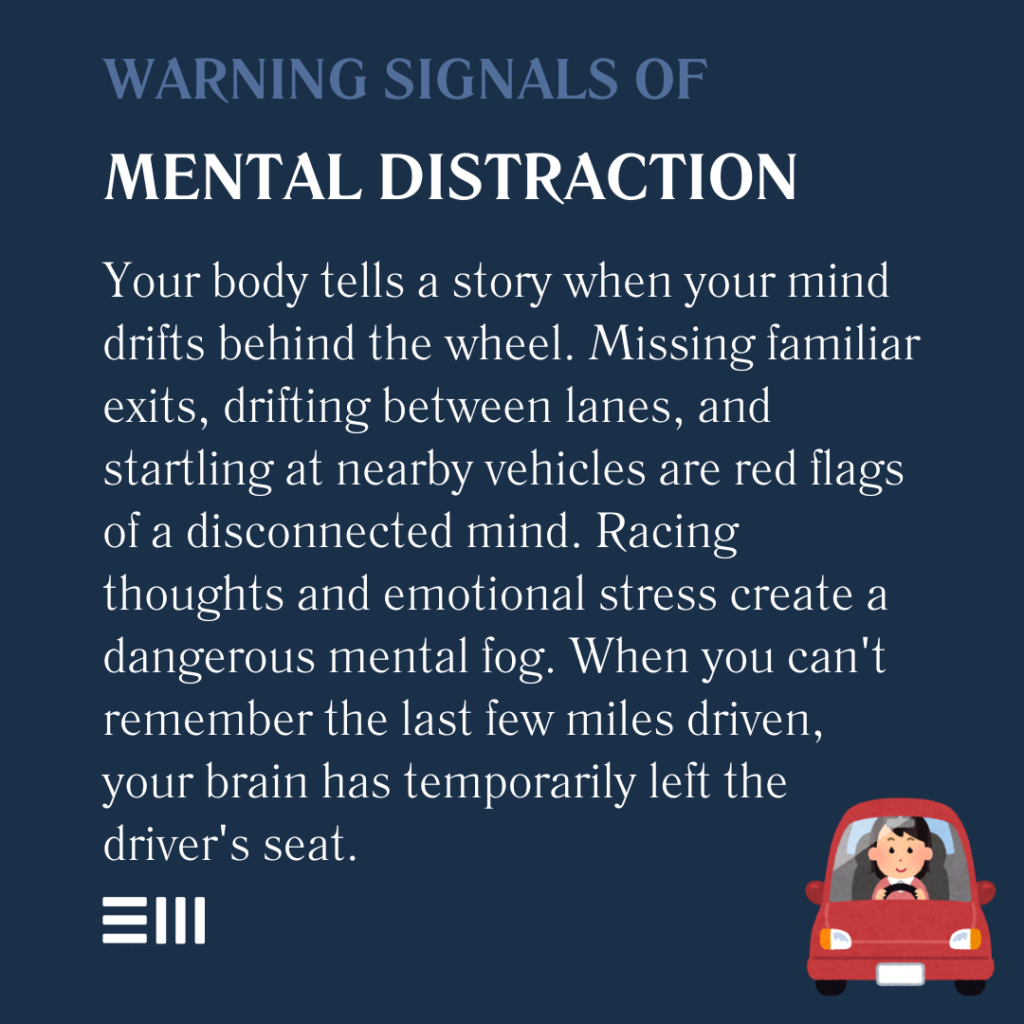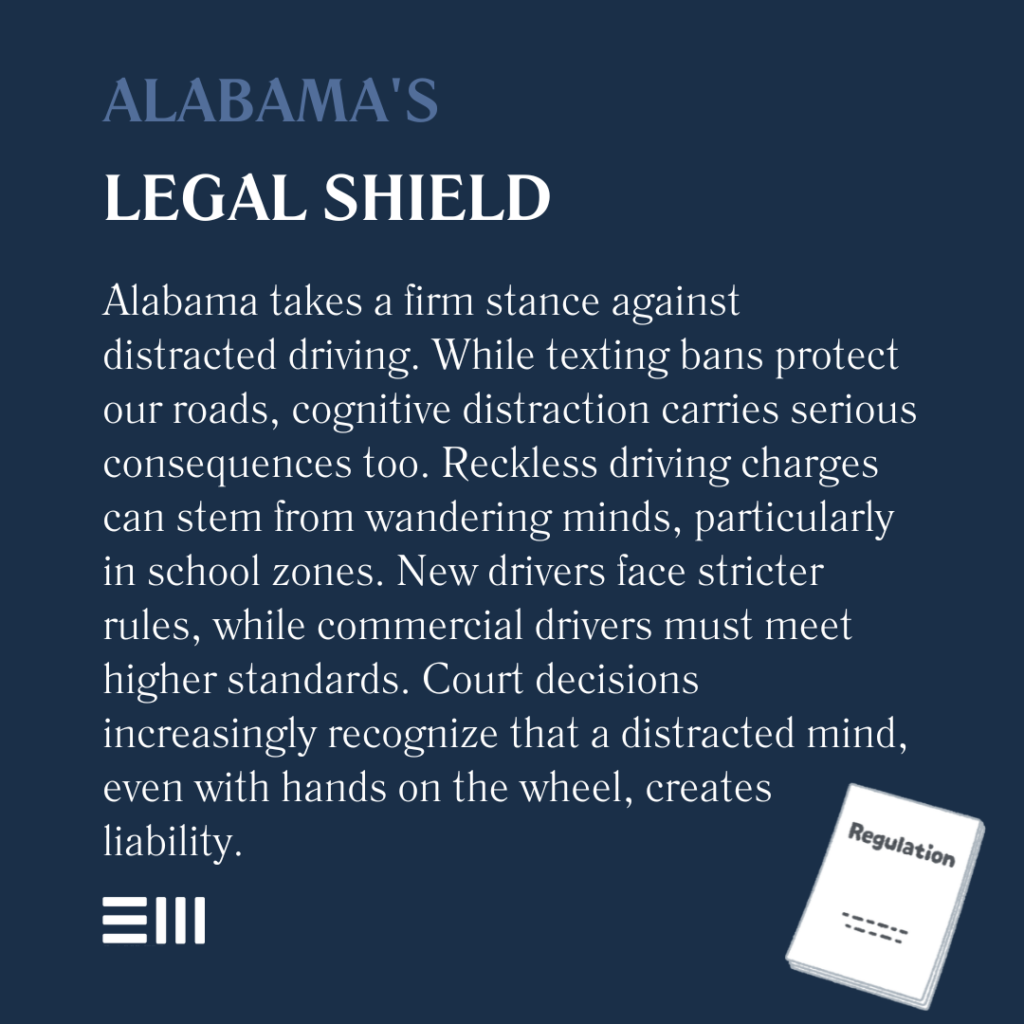
In 2022, distracted driving claimed 3,308 lives on American roads—equivalent to nine fully loaded passenger jets crashing.
Behind each statistic lies a preventable tragedy, often caused not by phones or food but by something far more subtle: our wandering minds.
While Alabama drivers understand the dangers of texting behind the wheel, cognitive distractions—from daydreaming to hands-free calls—pose an equally deadly threat that goes largely unrecognized.
Understanding Cognitive Distractions
The human brain processes about 11 million bits of information every second while driving, yet can only consciously handle 40 bits at a time. This cognitive limitation makes every moment of inattention potentially fatal.
Common forms of cognitive distraction include:
- Daydreaming or being lost in thought;
- Having intense emotional conversations;
- Planning upcoming activities or meetings;
- Listening to audiobooks or complex podcasts;
- Using hands-free phone systems; and
- Being preoccupied with work or personal stress.
These internal distractions often go unnoticed until it’s too late, making them particularly dangerous on Alabama’s busy highways and rural roads. Unlike physical distractions, cognitive distractions can persist long after the triggering event has passed.
These mental distractions have serious consequences on driving performance:
- Increased reaction time by up to 40%;
- Reduced visual scanning of mirrors and surroundings;
- Decreased awareness of changing traffic conditions;
- Impaired decision-making abilities;
- Higher likelihood of missing traffic signals; and
- Reduced ability to maintain consistent speed and lane position.
Understanding these impacts helps emphasize why maintaining mental focus while driving isn’t just a safety recommendation—it’s a critical necessity for protecting all road users.
Signs of Cognitive Distraction
Understanding the warning signs helps drivers recognize when they’re mentally disconnected from the task of driving. Keep watch for these indicators:
Physical Signs:
- Inability to recall the last few miles driven;
- Missing exits or traffic signals;
- Drifting between lanes;
- Inconsistent speed control;
- Delayed braking responses; and
- Finding yourself startled by other vehicles.
Recognition of these physical indicators serves as a crucial first line of defense against dangerous cognitive disconnection while driving.
Mental Signs:
- Racing thoughts unrelated to driving;
- Difficulty focusing on the road;
- Persistent worrying about work or personal issues;
- Replaying conversations in your head;
- Planning future events while driving; and
- Emotional distress affecting concentration.
Being able to identify these mental warning signs allows drivers to take corrective action before their distraction leads to dangerous situations on the road.

Prevention Strategies
Consider these practical approaches:
Before Driving:
- Complete any necessary phone calls;
- Set your GPS and music;
- Review your route;
- Address pressing concerns or thoughts;
- Practice mindfulness or brief meditation; and
- Ensure adequate rest.
These preparatory steps create a foundation for focused, safe driving before you even start your engine.
While Driving:
- Focus solely on the driving task;
- Scan mirrors every 5-8 seconds;
- Maintain a proper following distance;
- Take regular breaks on long trips;
- Use simple breathing techniques when stressed; and
- Pull over if you need to think through complex issues.
Implementing these strategies consistently can significantly reduce your risk of cognitive distraction-related incidents and help ensure safer journeys for everyone on Alabama roads.
The Legal Landscape in Alabama
Alabama’s distracted driving laws focus primarily on physical distractions, but cognitive distractions can still lead to legal consequences:
Current Laws:
- Ban on texting while driving;
- Restrictions on cell phone use for novice drivers;
- Reckless driving charges possible for cognitive distraction;
- Potential civil liability in accidents;
- Enhanced penalties in school zones; and
- Additional restrictions for commercial drivers.
These regulations form the foundation of Alabama’s approach to combating distracted driving, though enforcement of cognitive distraction remains challenging.
Penalties may include:
- Fines starting at $25 for first offense;
- Points on driving record;
- Insurance premium increases;
- Potential license suspension;
- Civil lawsuit liability; and
- Criminal charges in severe cases.
Understanding these legal consequences helps drivers appreciate the serious nature of distracted driving and its impact on both personal safety and legal liability.

Frequently Asked Questions About Distracted Driving in Alabama
The complexities of cognitive distraction while driving raise many important questions.
Here are detailed answers to the most common inquiries we receive from Alabama drivers.
What Constitutes Legal Liability for Cognitive Distraction?
While proving cognitive distraction can be challenging, evidence such as witness statements, lack of brake marks, or admission of being lost in thought can establish liability in accident cases.
Are There Any Apps or Tools to Help Prevent Cognitive Distraction?
Several technologies exist, including drowsiness detection systems and attention monitors, though the most effective tool remains self-awareness and proper rest.
These answers reflect current research and legal precedents, providing a framework for understanding the complexities of cognitive distraction while driving.
Protect Your Rights on Alabama Roads
Every Alabama driver deserves to reach their destination safely. If you’ve been affected by a distracted driving incident or need legal guidance, our experienced team stands ready to help protect your rights and pursue justice.
Contact Baxley Maniscalco today for a confidential consultation and learn how we can support your case with decades of combined experience in Alabama traffic law.
Can't find what you're looking for? Search our site below.










